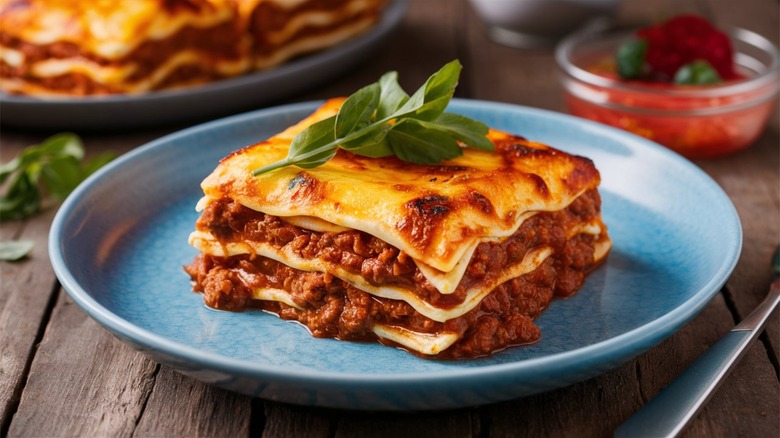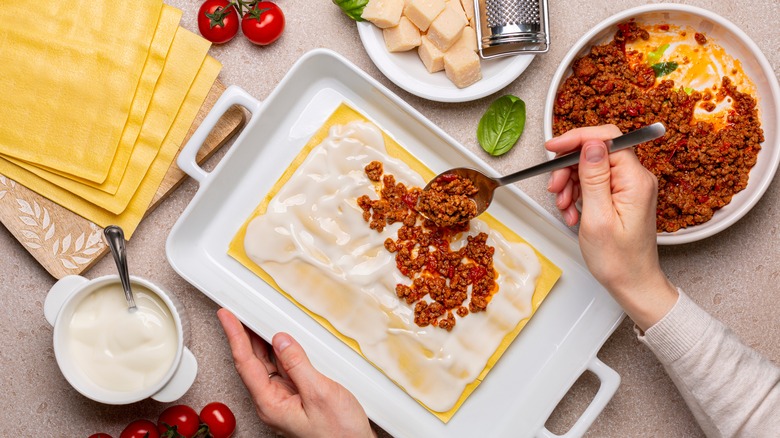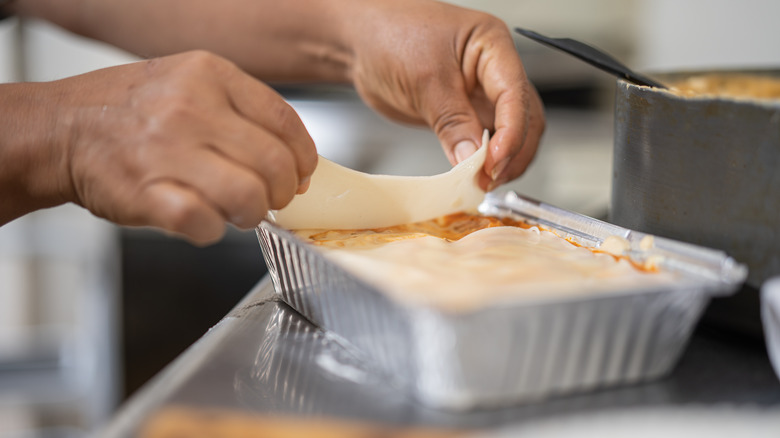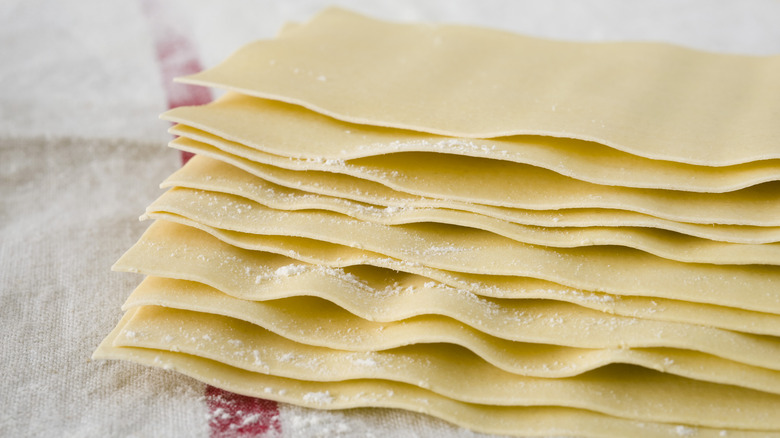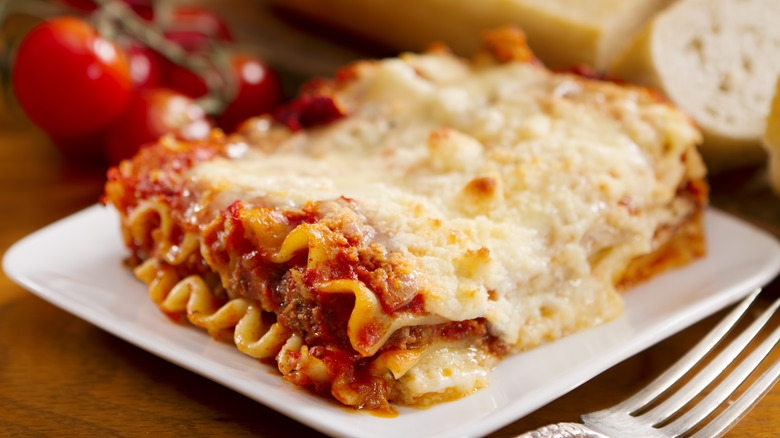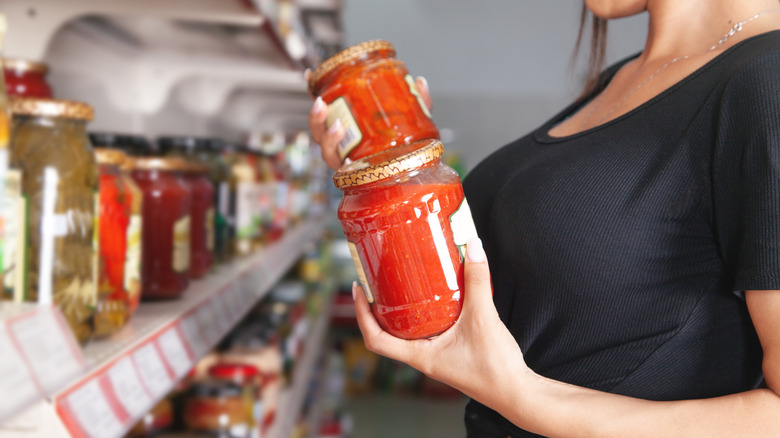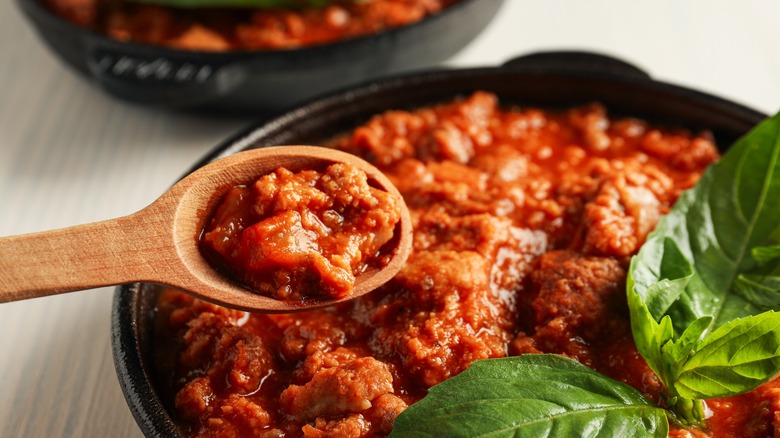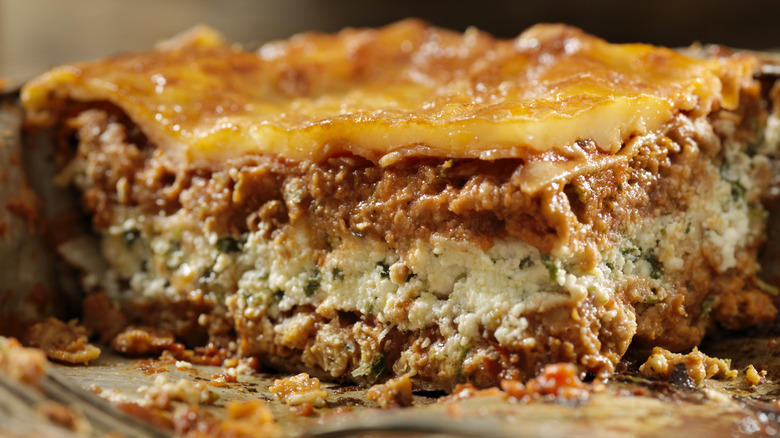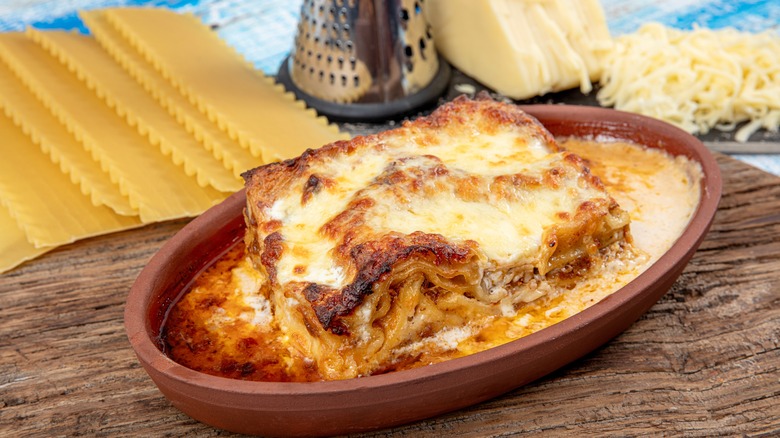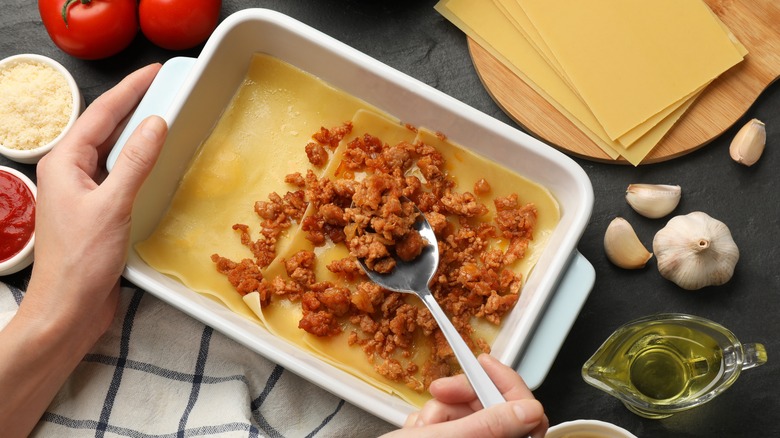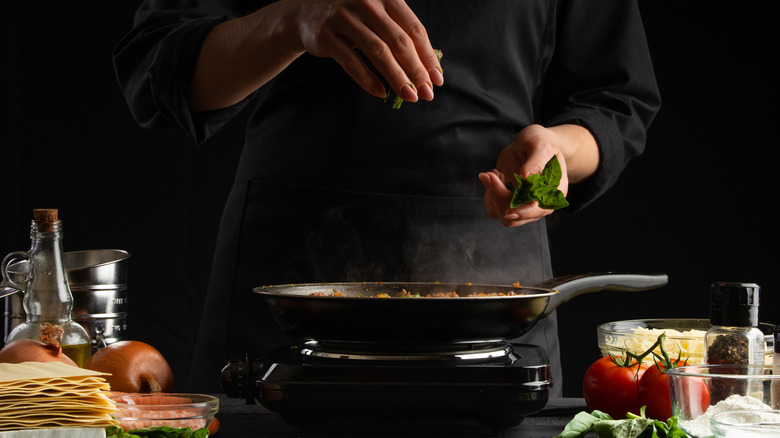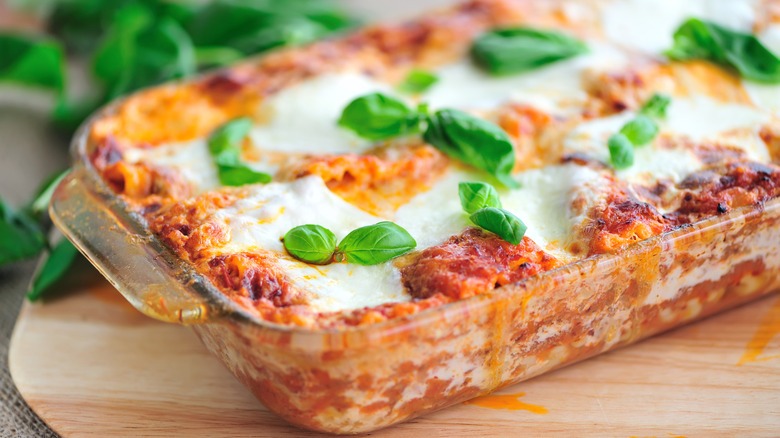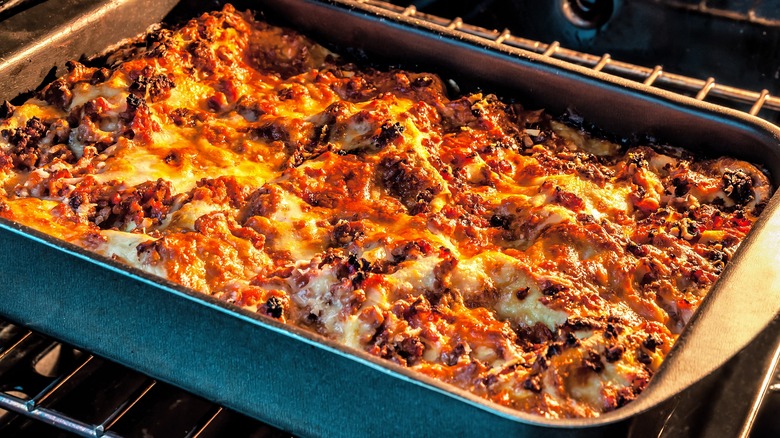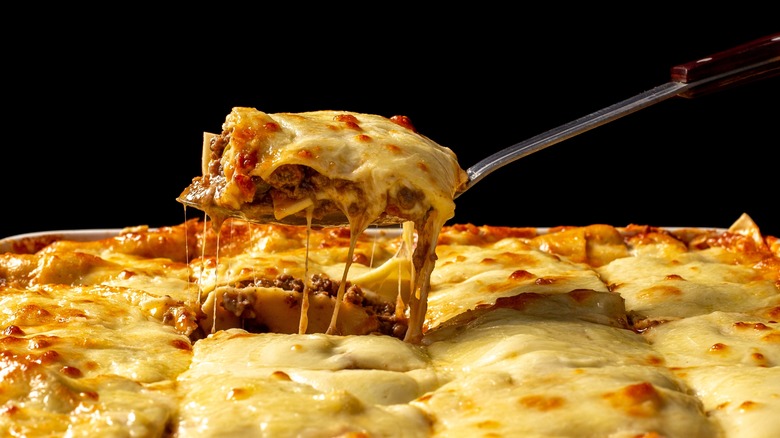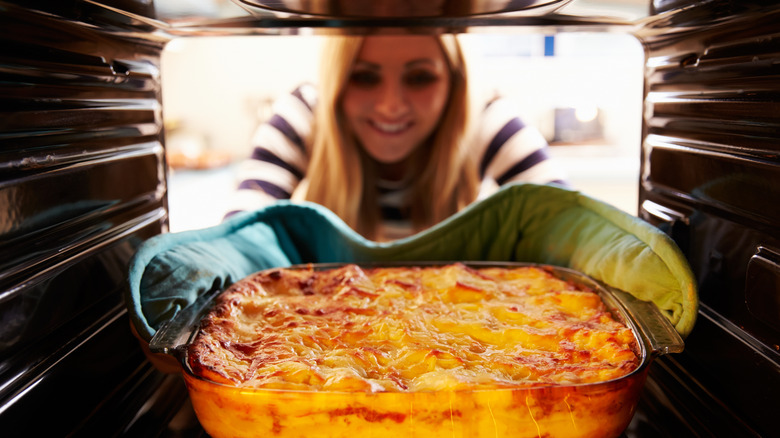Mistakes Everyone Makes When Cooking Lasagna
With its springy noodles, savory tomato sauce, and luscious layers of cheese, lasagna is the ultimate comfort food. Yet many home cooks have likely had a few experiences where their lasagna didn't come out exactly as they'd planned. Perhaps the finished product was soupy, or didn't pack the expected punch of flavors as the same dish you'd order from your favorite Italian restaurant.
Now, the internet is rife with tips for achieving the perfect lasagna — like Giada de Laurentiis's sheet pan hack for ultra-crispy edges, or the celebrity chef's method for whipping up lasagna in 30 minutes. However, it may be more helpful to instead discuss the many potential mistakes you might make, and ways to overcome them. Preparing lasagna is a multi-step process requiring several elements, after all, each of which leaves room for error.
To help you improve in any areas where you might be going wrong, we spoke to several chefs and cooking experts about the best ways to overcome common mistakes when cooking lasagna. These experts let us in on some of the biggest errors known to occur when making lasagna, and offered some savvy solutions to overcome those issues. Here are mistakes everyone makes when cooking lasagna at home and some tips to avoid those pitfalls.
Failing to have everything ready before assembling
There's no denying that making lasagna can be a time-consuming process. With so many steps involved, it can be a little chaotic if you don't have all your ducks in a row. Tony Benedict, executive chef of Sargento, said, "I'd definitely recommend having everything mise en place — that's the term us chefs use to say have everything in place and ready to go." He recommends that before you begin layering, you should have your cheese blend done and perfectly seasoned, the sauce consistency finalized, and the noodles cooked al dente.
If that sounds a tad overwhelming, Matt Harding, SVP of culinary and menu innovation at Piada Italian Street Food, gave a few tips for breaking it down into manageable steps. He said, "The myth is that making lasagna is an all-day affair. Work smart by preparing your sauce a day or two ahead, gathering all your ingredients, and doing prep steps on sauces or fillings." If you have everything ready to go, it should only take about 15 minutes to assemble your lasagna, plus baking time. Some of the easiest mise en place to assemble is having your ground meat prepared and sauced, and any fresh herbs or cheese finely shredded.
Not using fresh pasta
Most home cooks save themselves time and energy by using store-bought lasagna noodles. However, many chefs will tell you that you just won't get the same results from dried pasta that you'll get from fresh, homemade lasagna noodles. Eric Sornoso, co-founder of Mealfan, said "If possible, use fresh pasta sheets instead of dried ones. Fresh pasta cooks faster and absorbs the flavors of the sauce more effectively, resulting in a more cohesive dish."
Kevin Ashton, culinary advisor of Restaurantji, seconded that notion. According to him, you just can't beat the taste and texture you get from fresh egg pasta made by hand. Ashton said, "Initially, it may seem like a lot of work, but the effort is worth it. Not only will your lasagna burst with flavor, but it will also impress anyone you serve it to."
Not only will fresh noodles impact flavor, but fresh pasta has a rougher texture that can make your dish more cohesive by capturing and holding onto sauce and cheese. But, if you don't have time to make fresh noodles from scratch, it's worth having a look at your local grocery store to see if they sell fresh lasagna noodles. Certain chains like Whole Foods and Wegmans have been known to carry them.
Overcooking the lasagna sheets
There's nothing worse than taking a bite of lasagna and getting a mouthful of mushy noodles. Soggy noodles not only have an unappetizing mouthfeel, but they can also affect the structural integrity of your lasagna. The main culprit? Usually, it's overcooked noodles. You don't need to fully cook your noodles before adding them to the lasagna because they will continue to cook once they're in the oven. Tony Benedict said, "I would recommend cooking the noodles right to al dente, then removing them from the water."
You might think that using no-boil noodles would solve the problem of badly textured noodles and save you some time, but many chefs say that's not actually the case. Jessica Randhawa of The Forked Spoon cautioned, "They can sometimes be too tough or, conversely, become too soggy. Traditional boiled noodles, slightly undercooked, usually provide better results."
You can also use dry, uncooked noodles in your lasagna if you want to save yourself some time. Keep in mind though that with dry noodles you'll need more moisture in the lasagna to ensure they cook properly. Benedict recommends having about 50% more moisture in your sauce than you would if you were using pre-cooked noodles.
Ignoring pasta filata cheeses
The cornerstone of any good lasagna is the cheese. Ideally, you want cheeses that melt into gooey goodness and have a great pull. Tony Benedict said, "For cheese, I always use a pasta filata style, like a mozzarella or provolone."
For those who aren't familiar with the term, pasta filata refers to the technique of heating and stretching cheese to give it an elastic consistency. Benedict said, "Pasta filata cheeses have a unique texture — almost stretchy, smooth, and firm, depending on the cheese you're using."
Another thing many of the experts recommended is using high-quality cheeses and grating them yourself. Pre-shredded cheese just won't give you the same consistency and can even make the mouthfeel of your lasagna off-putting. Eric Sornoso said, "Pre-shredded cheese contains anti-caking agents that prevent it from melting smoothly, resulting in a gritty texture." Most chefs recommend using fresh mozzarella and freshly grated Parmesan. Some other cheeses that work well in lasagna include fontina, asiago, and ricotta.
Using store-bought sauces
Another area where home cooks often cut corners is the sauce. Buying a store-bought sauce will save you time, but many experts say it just won't give you star-quality lasagna. As Kevin Ashton said, "While ready-made sauce may be practical, it compromises the taste of your dish." With this in mind, it's best to prepare ahead of time if you want to make the best lasagna possible.
One of the best tips for making homemade pasta sauce is to start with top-notch ingredients. In other words, be sure to opt for fresh veggies, herbs, and meats. If you're using canned tomatoes, seek out San Marzano tomatoes. Another tip is not to rush your sauce. It needs time to simmer down so the flavors meld and it reduces into a proper consistency.
This last step is crucial to ensuring the final product is structurally sound on the plate. After all, as Bill Dorrler, executive chef of Osteria Morini, told Chowhound, "a sauce that isn't properly reduced won't hold its shape when serving."
Making the sauce too thick or too thin
Consistency is key when it comes to your lasagna sauce — in both directions. In fact, a common mistake identified by Eric Sornoso is the use of a sauce that's either too thin or too thick to work in the dish. "A thick sauce can make the lasagna overly dense," Sornoso noted, "while a watery sauce can cause it to fall apart."
Of course, many chefs err on the side of a thicker tomato sauce to avoid a sloppy lasagna. Nic Vanderbeeken, executive chef at Aperitif, said, "A common mistake with the sauce is making it too watery." To counteract this concern, Vanderbeeken noted your sauce should simmer for a long enough time period to properly thicken before assembly.
Ideally, you want a robust tomato sauce that will help bind the layers of your lasagna together without overpowering the other elements. A thin, watery marina just won't cut it, but neither will one that's too thick. And yes: there is a difference between marinara and tomato sauce. Tomato sauce typically incorporates crushed tomatoes, meat, butter, and broth, while marinara often includes just tomatoes and seasoning.
Believing lasagna must include ricotta cheese
One of the biggest debates among die-hard lasagna fans is whether traditional lasagna should have ricotta or béchamel sauce. Lasagna is typically made with ricotta in southern Italy, while northern Italian recipes often use béchamel instead. Ricotta is a popular choice for many home cooks because the only extra step is straining the ricotta before using it. However, many chefs say that béchamel might actually give you a better tasting lasagna.
As Nic Vanderbeeken told us, "A myth I'd like to debunk is that lasagna must always include ricotta cheese. While traditional, I find that a béchamel sauce can create an equally delicious, creamy layer, especially in white lasagna variations." Now, making this type of sauce might sound daunting, but it's actually not that complicated. A classic béchamel sauce recipe consists of butter, flour, milk, and seasonings like salt, pepper, and nutmeg. All up, it should only take about 15 to 20 minutes to make.
Including too much moisture in the mix
Is there anything sadder than slaving away over a lasagna only to cut into it and find that it's a soupy mess? We think not. This may be why, according to Matt Harding, "The biggest mistake is having too much moisture in the ingredients." This can lead to a thinner sauce than ideal, which increases the risk of soggy noodles, Harding noted.
Some other things that could be making your lasagna too watery include ricotta that hasn't been strained, or vegetables that haven't had enough water cooked out of them. Additionally, the temperature of your sauce may also be an issue, as Mike Alaridi, executive chef of Miss Ricky's restaurant at Virgin Hotels Chicago, told Chowhound. "Typical mistakes ... are using only one type of sauce and building the lasagna with the sauce warm or hot."
Alaridi stated he incorporates a trio of sauces (béchamel, bolognese, and pomodoro), which are fully cooled before the lasagna itself is prepared. If your sauce is piping hot when you add it to the lasagna, it can soak into the noodles too quickly, which can result in overcooked, mushy noodles.
Layering incorrectly
Once you have your noodles, cheese, and sauce sorted, it's time for the fun part — layering. But what goes first? Most of the experts we spoke to agree that sauce should be the first thing you add to the baking dish or pan because it prevents the noodles from sticking to the pan. You can also spray the bottom of the pan with cooking spray or add butter to prevent sticking.
Another common mistake people make with layering is not evenly distributing the ingredients. Eric Sornoso said, "Uneven layers can cause the lasagna to cook inconsistently, with some parts being too dry and others too wet." The trick is to make sure that the pasta sheets, sauce, and cheeses are evenly distributed.
You may be tempted to go heavy on the cheese or meat sauce to make your lasagna extra gooey or hearty. However, it's all about balance. As Bill Dorrler said, "While everyone loves a good cheese pull, the sauce-to-cheese-to-meat (or veggie) ratio needs to be just right for the perfect bite." You don't necessarily need to cover each layer completely with cheese or meat sauce. You can spread them out or alternate layers with stronger flavors like olives or anchovies.
Neglecting to season each layer
While home cooks may be hesitant to use too much salt, pepper, or other seasoning in their cooking, professional chefs know that you need to season food every step of the way for a better tasting dish. Lasagna is no exception. To avoid a lackluster lasagna, you should be seasoning every layer. You can start by adding salt, pepper, and fresh or dried herbs to your sauce and cheeses. As you add each layer, sprinkle it with additional seasoning to ensure every bite pops with flavor.
Salt and pepper are the most obvious choices for seasoning, but they're not the only options. Mike Alaridi recommended adding dried oregano, nutmeg, and olive oil for better flavor. He also suggested adding a layer of bechamel sauce on top of the lasagna for a richer taste. Some other ways to upgrade lasagna include adding lemon zest to the ricotta or a dash of cinnamon to the sauce. Just be sure to taste and adjust your seasonings as you go. Remember that you can always add more, but it's much harder to remove ingredients once they're in there.
Overfilling the pan
Lasagna is one of those dishes that's meant to be hearty and abundant. However, that doesn't mean you need to go overboard. Many home cooks make the mistake of piling the layers too high. As with any casserole-style dish, overfilling the pan is a recipe for disaster. An overloaded lasagna may not cook evenly, meaning you could end up with incinerated edges and a cold center. It could also overflow, making a giant mess in your oven (then there's the issue of trying to wrestle the slices out of the pan).
To counteract this mistake, Tony Benedict suggests being gentle during the assembly process and avoid overfilling. Since the dish requires room to bake properly, Benedict believes "three layers are just fine." Of course, there's no hard and fast rule for how many layers a lasagna should have.
Most recipes call for at least three, but you can add more if your pan is deep enough. The trick is to make sure each layer is consistent and to leave room at the top for the cheese and sauce to bubble up. Bill Dorrler recommends placing the lasagna on a sheet tray while baking to catch any potential boil-over.
Baking the lasagna uncovered
To cover or not to cover your lasagna — that's an often-asked question. According to many chefs, there are several reasons why you should always cover your lasagna before baking it. Sunita Yousef of The Wannabe Cook said, "When lasagna is baked without a cover, it often results in a dry dish with a burnt top. Covering lasagna with aluminum foil is crucial to prevent the top layer from burning while ensuring the middle heats thoroughly."
You may be wondering how you can get that coveted golden top and crispy edges with a covered lasagna. Many chefs say the trick is adding the cheese right at the end and doing a quick broil. Mike Alaridi recommends covering the lasagna in aluminum foil and baking it for 45 minutes. Once it's cooked through, you can remove the cover, add your cheese, and then stick the lasagna under the broiler for about five minutes to get that delicious, golden brown crust.
Cutting the lasagna too quickly out of the oven
After smelling all those delicious aromas wafting out of the oven, you may be tempted to dig into your lasagna the minute it comes out. Unfortunately, that would be a huge mistake. If you cut into that piping hot lasagna, there's a high probability that the juices will come spilling out and the lasagna will lose its shape.
Simply put, resting is a crucial step that lets your lasagna firm up while allowing the flavors to come together. "I always let my lasagna rest for at least 15 to 20 minutes before cutting into it," Nic Vanderbeeken told us. This extra period of time allows the layers to settle, which will ensure your lasagna stays intact after you slice and serve it.
Additionally, after the lasagna has rested, Sunita Yousef recommends cutting it with a sharp knife and using a flexible spatula to carefully lift each piece out of the pan. "These steps ensure that each serving is visually pleasing and delicious, preserving its integrity and taste," Yousef said, since any extra sauce or cheese will be scooped onto your plate.
Forgetting to having fun with it
With all this talk about the potential mistakes that can happen at every step of the lasagna-making process, you may be wondering if it's worth the hassle. One thing that many of our experts pointed out is that it doesn't have to be a slog. You can — and should — have fun with it.
Cooking lasagna can be an incredibly creative process where you can express your unique tastes and personality. Don't be afraid to try new ingredients. Find out which flavors work best for you and run with that. Mistakes might be made, but that doesn't necessarily mean the whole meal will be ruined. As Matt Harding said, "You might be creating a memorable meal, and mistakes can become cherished stories."
The most important thing to remember is not to panic. Break down the process into manageable steps and use fresh, quality ingredients that you love. Your lasagna doesn't have to be ultra-traditional or look like it came off the pages of a cooking magazine. If you're happy with it, that's a win!
